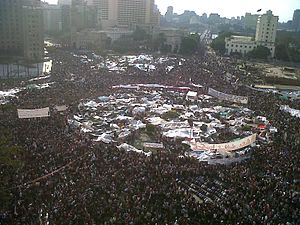ഈജിപ്ഷ്യൻ പ്രക്ഷോഭം (2011)
2011 ജനുവരി 25 മുതൽ ഈജിപ്റ്റിന്റെ തെരുവുകളിൽ നടന്നുകൊണ്ടിരിക്കുന്ന പ്രകടനങ്ങൾ,സമ്മേളനങ്ങൾ,നിസ്സഹകരണ പ്രതിഷേധങ്ങൾ, കലാപങ്ങൾ തുടങ്ങിയവയാണ് 2011-ലെ ഈജിപ്ഷ്യൻ പ്രക്ഷോഭം എന്ന് വിളിക്കപ്പെടുന്നത്. പാപ്പിറസ് വിപ്ലവം എന്ന് ഇത് ഇന്റർനെറ്റിൽ വ്യാപകമായി വിശേഷിപ്പിക്കപ്പെടുന്നു. കയ്റോവിലും ഈജിപ്റ്റിന്റെ ഇതര പട്ടണങ്ങളിലും ആയിരക്കണക്കിനു ജനങ്ങൾ ഉൾക്കൊള്ളുന്ന മാർച്ചുകളോടെയാണ് ഈ പ്രക്ഷോഭം ആരംഭിക്കുന്നത്.[21] പ്രാദേശികമായ പ്രതിഷേധങ്ങൾ മുൻ വർഷങ്ങളിൽ ഈജിപ്റ്റിൽ സ്ഥിരമായിരുന്നങ്കിലും 2011-ലെ ഈ പ്രക്ഷോഭം 1997-ലെ ബ്രഡ് കലാപത്തിനു ശേഷം ഈജിപ്റ്റ് കണ്ട ഏറ്റവും വലിയ പ്രതിഷേധ കലാപമാണ്. വിവിധ വിശ്വാസികളേയും വിവിധ കോണിലുള്ള സാമൂഹ്യ-സാമ്പത്തിക പശ്ചാതലമുള്ളവരുടേയും പങ്കാളിത്തം കൊണ്ട് ഈ പ്രക്ഷോഭം അസാധരണമായ ഒന്നായി കണക്കാക്കപ്പെടുന്നു.
| 2011 Egyptian Revolution | |||||||||||
|---|---|---|---|---|---|---|---|---|---|---|---|
| Part of the Egyptian Crisis and the Arab Spring | |||||||||||

| |||||||||||
| Demonstrators in Cairo's Tahrir Square on 8 February 2011 | |||||||||||
| |||||||||||
| Number | |||||||||||
| 2,000,000 at Cairo's Tahrir Square[15] See: Regions section below. | |||||||||||
| Casualties | |||||||||||
| |||||||||||

തുണീഷ്യയിലെ 2011 ലെ പ്രക്ഷോഭം ആരംഭിച്ച് ഒരാഴ്ചക്കകമാണ് ഈജിപ്റ്റിന്റെ തെരുവിലും പ്രകടനക്കാരും കലാപകാരികളും പ്രതിഷേധങ്ങളുമായി ഉയർത്തെഴുന്നേറ്റത്. പ്രക്ഷോഭകരിൽ പലരും തങ്ങളുടെ പ്രക്ഷോഭത്തിലെ തുണീഷ്യൻ സ്വാധീനം പ്രതീകവൽകരിക്കാൻ തുണീഷ്യൻ പതാക കൈലേന്തിയത് കാണാമായിരുന്നു. പോലീസിന്റെ ക്രൂരത,രാജ്യത്ത് നിലവിലുള്ള അടിയന്തരാവസ്ഥാനിയമം,സ്വതന്ത്രമായ തിരഞ്ഞെടുപ്പിന്റയും അഭിപ്രായസ്വാതന്ത്ര്യത്തിന്റെയും അഭാവം,അഴിമതി,ഉയർന്ന തൊഴിലില്ലായ്മ നിരക്ക്,വിലക്കയറ്റം, കുറഞ്ഞ കൂലി എന്നീ നിരവധി പ്രശ്നങ്ങളാണ് പ്രക്ഷോഭത്തിനു നിമിത്തമായത്. സ്വാതന്ത്ര്യത്തിനും നീതിക്കും ഹുസ്നി മുബാറക്കിന്റെ ഭരണം അവസാനിപ്പിക്കുന്നതിനും ഈജിപ്ഷ്യൻ ജനതയുടെ താല്പര്യങ്ങൾ പ്രതിനിധീകരിക്കുന്ന ഒരു സർക്കാറിനും വേണ്ടി പ്രക്ഷോഭകാരികൾ ആവശ്യമുന്നയിച്ചിട്ടുണ്ട്.
റബ്ബർ ബുള്ളറ്റുകൾ, ബാറ്റൺ, ജലപീരങ്കികൾ, കണ്ണീർ വാതകം എന്നിവ ഉപയോഗിച്ച് പ്രക്ഷോഭകാരികളെ ഈജ്പ്ഷ്യൻ സർക്കാർ ഇല്ലാതാക്കാനും തകർക്കാനും ശ്രമിച്ചു വരുന്നു. എങ്കിലും ആളപായം പലയിടത്തു നിന്നും റിപ്പോർട്ട് ചെയ്യപ്പെട്ടിട്ടുണ്ട്. 2011 ജനുവരി 29 വരെ കുറഞ്ഞത് 105 ആളുകൾ മരണമടഞ്ഞതായി റിപ്പോർട്ട് ചെയ്യപ്പെടുന്നു. പരിക്കുപറ്റിയവരിൽ 750 പോലീസുകാരും 1500 പ്രതിഷേധക്കാരും ഉൾപ്പെടുന്നു. തലസ്ഥാന നഗരിയായ കൈറോ ഒരു യുദ്ധ മേഖലയായും കപ്പൽ താവള നഗരമായ സൂയസ് തുടരെയുള്ള അക്രമാസക്തമായ പോരാട്ടങ്ങൾക്ക് വേദിയാവുന്നതായും വിവരിക്കപ്പെടുന്നു.
പ്രതിഷേധങ്ങളോടുള്ള രാജ്യാന്തര തലത്തിലുള്ള പ്രതികരണം സമിശ്രമായിരുന്നു. മിക്കവരും ഇരുപക്ഷത്തു നിന്നും സമാധാന പ്രതിഷേധങ്ങൾ വേണമെന്ന് ആവശ്യപ്പെടുന്നവരായിരുന്നു.അതുവഴി രാജ്യത്തിൽ ഒരു പരിഷ്കാരം വേണമെന്ന് ആഗ്രഹിക്കുന്നവരും. പലരാജ്യങ്ങളും ഈജിപ്റ്റിലുള്ള തങ്ങളുടെ പൗരന്മാർക്ക് യാത്രാ നിർദ്ദേശങ്ങൾ നൽകുകയും അവരെ അവിടെ നിന്ന് കോണ്ടുവരുന്നതിന് ശ്രമിച്ചു കൊണ്ടിരിക്കുകയും ചെയ്യുന്നു.
പ്രതിഷേധങ്ങളെ ഇല്ലാതാക്കുന്നതിനു വേണ്ടി ഹുസ്നി മുബാറക്ക്, തന്റെ സർക്കാറിനെ പിരിച്ചുവിടുകയും പട്ടാളമേധാവിയും ഈജിപ്ഷ്യൻ ചാരസംഘടനയുടെ മുൻ തലവനുമായ ഒമർ സുലൈമാനെ വൈസ് പ്രസിഡണ്ടാക്കി അവരോധിക്കുകയും ചെയ്തു.
ഹുസ്നി മുബാറക്ക് പ്രസിഡന്റ് പദവി ഒഴിയുന്നതായും പട്ടാളത്തെ ഭരണം ഏല്പിക്കുന്നതായും 2011 ഫെബ്രുവരി 11 ന് വൈസ്പ്രസിഡന്റ് ഒമർ സുലൈമാൻ പ്രഖ്യാപിച്ചു. [22]. മുബാറക് കൈറോ വിട്ടുവെന്നും ഷറമുൽ ഷൈഖിലെ ചെങ്കടൽ തീര റിസോർട്ടിലുള്ള തന്റെ ഭവനത്തിലേക്ക് പോയതായും ഔദ്യോഗിക റിപ്പോർട്ടുകൾ സൂചിപ്പിക്കുന്നു. .[23]
നാൾവഴികൾ
തിരുത്തുക2011 ജനുവരി 25 മുതൽ ഈജിപ്തിലെ ബഹുജന പ്രക്ഷോഭകാരികൾ ഹുസ്നി മുബാറക്ക് പ്രസിഡണ്ട് സ്ഥാനം ഒഴിയണമെന്നാവശ്യപ്പെട്ട് പ്രക്ഷോഭം തുടങ്ങി2011 ഫെബ്രുവരി 1-നു് അടുത്തു നടക്കാനിരിക്കുന്ന പ്രസിഡണ്ട് തെരഞ്ഞെടുപ്പിൽ മത്സരിക്കില്ലെന്ന് മുബാറക്ക് പ്രഖ്യാപിച്ചു. 2011 ഫെബ്രുവരി 5-നു് മുബാറക്കടക്കം ഭരണത്തിലിരിക്കുന്ന നാഷണൽ ഡെമോക്രാറ്റിക് പാർട്ടിയുടെ എല്ലാ നേതാക്കളും രാജിവെച്ചതായി ഈജിപ്ഷ്യൻ സ്റ്റേറ്റ് മീഡിയ പ്രഖ്യാപിച്ചു . എന്നാൽ പിന്നീട് മുബാറക്ക് തന്നെ പ്രസിഡണ്ട് സ്ഥാനത്തു തുടരുമെന്നറിയിച്ചു.
2011 ഫെബ്രുവരി 11-നു് വൈസ് പ്രസിഡണ്ടായ ഒമർ സുലൈമാൻ, ജനുവരി 25-ൽ മുതലാരംഭിച്ച ബഹുജന പ്രക്ഷോഭത്തെത്തുടർന്ന് പ്രസിഡണ്ടായ ഹുസ്നി മുബാറക്ക് രാജിവെക്കുന്നതായും രാജ്യത്തിന്റെ ഭരണം ഈജിപ്ഷ്യൻ ആർമിക്ക് നൽകുന്നതായും പ്രഖ്യാപിച്ചു[24].
അവലംബം
തിരുത്തുക- ↑ 1.0 1.1 1.2 "Egypt braces for nationwide protests". France 24. Agence France-Presse. 25 January 2011. Archived from the original on 1 February 2011. Retrieved 29 January 2011.
- ↑ 2.0 2.1 "Egypt activists plan biggest protest yet on Friday". Al Arabiya. 27 ജനുവരി 2011. Archived from the original on 1 ഫെബ്രുവരി 2011. Retrieved 29 ജനുവരി 2011.
- ↑ 3.0 3.1 3.2 "Egypt protests a ticking time bomb: Analysts". The New Age. South Africa. Agence France-Presse. 27 ജനുവരി 2011. Archived from the original on 9 ഫെബ്രുവരി 2011. Retrieved 29 ജനുവരി 2011.
- ↑ Korotayev, A.; Zinkina, J. (2011). "Egyptian Revolution: A Demographic Structural Analysis". Entelequia. Revista Interdisciplinar. 13: 139–169.
- ↑ "Egypt's prime minister quits, new govt soon-army". Forexyard.com. Archived from the original on 2011-05-01. Retrieved 5 March 2011.
- ↑ Egypt's Mubarak Steps Down; Military Takes Over, The Wall Street Journal, 11 February 2011.
- ↑ "Egypt's military moves to dissolve parliament, suspend constitution". Haaretz. Reuters. 29 November 2010. Archived from the original on 14 February 2011. Retrieved 24 February 2011.
- ↑ "Egyptian state security disbanded". 15 March 2011. Archived from the original on 16 March 2011. Retrieved 15 March 2011.
- ↑ Egypt dissolves former ruling party http://english.aljazeera.net/news/middleeast/2011/04/2011416125051889315.html
- ↑ "How the mighty have fallen". Al-Ahram Weekly. 2 ഫെബ്രുവരി 2011. Archived from the original on 1 May 2011. Retrieved 23 March 2011.
- ↑ Kirkpatrick, David D.; Stack, Liam (13 March 2011). "Prosecutors Order Mubarak and Sons Held". The New York Times. Archived from the original on 16 April 2011. Retrieved 13 April 2011.
- ↑ "Mubarak to be tried for murder of protesters". Reuters. 24 May 2011. Archived from the original on 31 May 2011. Retrieved 24 May 2011.
- ↑ "Egypt's state of emergency ends after 31 years". The Daily Telegraph. London. 31 May 2012.
- ↑ "Mohammed Morsi sworn in as Egypt's president". CBS News. 30 June 2012. Retrieved 17 November 2012.
- ↑ "Estimated 2 Million People Protest in _ Around Tahrir Square in Cairo Egypt.mp4 | Current News World Web Source for News and Information". Cnewsworld.com. Archived from the original on 18 ഫെബ്രുവരി 2011. Retrieved 20 ഫെബ്രുവരി 2011.
- ↑ "Egypt's revolution death toll rises to 384". Al Masry Al Youm. 22 February 2011. Archived from the original on 14 March 2011. Retrieved 22 February 2011.
- ↑ "846 killed in Egypt uprising". 20 April 2011. Archived from the original on 20 April 2011. Retrieved 20 April 2011.
- ↑ "924 killed in Egyptian Revolution". 31 December 2011. Archived from the original on 2012-01-06. Retrieved 31 December 2011.
- ↑ "Activists on Facebook: the military killed 99 and wounded 2702 in 10 months". Tahrirnews.com. 30 December 2011. Archived from the original on 2015-09-05. Retrieved 6 January 2012.
- ↑ Faisal Al Yafai (12 November 2012). "Egypt's army fails to grasp the post-Mubarak realities – The National". Thenational.ae. Archived from the original on 2017-06-22. Retrieved 17 November 2012.
- ↑ "Net down, special forces deployed in Cairo as Egypt braces for protests" - News Limited - Retrieved 1 February 2011.
- ↑ Hosni Mubarak resigns as president Al-Jazeera English. 11 Feb 2011
- ↑ Yolande Knell. "BBC News - Egypt crisis: President Hosni Mubarak resigns as leader". Bbc.co.uk. Retrieved 2011-02-11.
- ↑ "പ്രത്യാശയുടെ പ്രതിരൂപങ്ങൾ" (PDF). മലയാളം വാരിക. 2012 ജനുവരി 6. Archived from the original (PDF) on 2016-03-06. Retrieved 2013 ഫെബ്രുവരി 20.
{{cite news}}: Check date values in:|accessdate=and|date=(help)